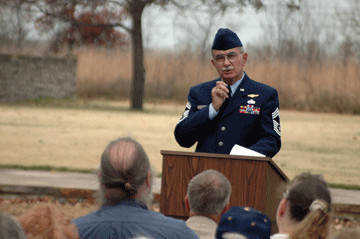Cost of freedom the focus of FSNHS program

The winds gusted Sunday afternoon, whipping the flags that were held high and blowing the occasional hat off of a local volunteer.
But the wind did nothing to deter several Fort Scott National Historic Site volunteers and about 30 local residents who turned out at the fort to meet their goal that day; to honor and serve tribute to the nation's greatest heroes -- its veterans.
"America's heroes must never be forgotten," Lawrence Cripps, a retired chief master sergeant and combat veteran, told the crowd Sunday during a special Veterans Day event on the fort grounds. "The men and women who have bravely stepped forward to answer the call...take time this Veterans Day to remember them all. God Bless America."
Cripps was the keynote speaker during a program titled, "A Time to Honor the Cost of Freedom," in which Cripps provided background on Veterans Day, which was first known as Armistice Day in 1918 at the culmination of World War I. The first Veterans Day observance took place in 1953 in Kansas.
Cripps was a U.S. Navy aviator and flight engineer during his 33 years of active duty. He had also worked for several years as a trooper for the Missouri State Highway Patrol.
Well-known area historian Arnold Schofield, another speaker at the event, said that more than 600,000 American soldiers, sailors and Marines died during the American Civil War, which took place from 1861-1865. After the Civil War, Kansas became known as the Great Soldier State, as more and more soldiers and travelers settled in the area between 1870 and 1885.
Schofield worked for 25 years as a site historian for the National Park Service, and retired in early 2005 after a 42-year career in federal service. He currently serves as the site administrator at Mine Creek Battlefield State Historic Site near Pleasanton, which is operated by the Kansas State Historical Society and tells the story of the October 1864 battle between Union and Confederate forces.
He continues to volunteer at the fort when needed. Before moving to Fort Scott, Schofield served in the U.S. Army from 1960 to 1963.
Park volunteer Robert "Skip" Thomas said Fort Scott was founded in 1842 during a major westward expansion in the United States. At that time, U.S. Army Capt. Thomas Swords had a goal to build the fort, calling it "The Crack Post of the Frontier." Most of the people Swords employed to build the fort were soldiers who had no carpentry or construction experience, Thomas said.
"Many of them couldn't even draw a straight line," he said.
Thomas also talked about the history of Fort Scott soldiers between 1842 and 1873.
Most of the fort buildings that currently stand at the site have been rebuilt, although some still stand unchanged in their original locations more than 150 years later. Thousands of troops passed through Fort Scott during the Civil War, and the fort served several purposes up through the conclusion of the war in 1865, although no battles were fought in Fort Scott, Thomas said.
Fort Scott Community College history instructor John Seals also spoke at the event, talking about what the concept of Veterans Day means to him.
"For you heroes, you're the reason why I teach," Seals said. "Thank you; you protect our freedoms."
Seals said he intended to bring a student with him to also speak on the topic of Veterans Day, but the student was unable to attend because he was playing football on Sunday against Butler Community College.
On average, eight people die each week in military service, Seals said.
The Blue and Gray Brass Brigade Band, a seven-piece band from Kansas City, Kan., concluded the event by playing the theme songs of all military branches, as the veterans of those branches stood and were acknowledged by others in attendance. The band also played other popular patriotic music from the 19th and early 20th centuries. The FSNHS color guard presented and retired the colors.
More than 25 million Americans served in the U.S. armed forces, from the American Revolution to today's War on Terror.
FSNHS is a repository for artifacts relating to the 1840s-era U.S. Army frontier military outpost. Those artifacts and the fort, itself, tell the story of Fort Scott between 1842 and 1873.
